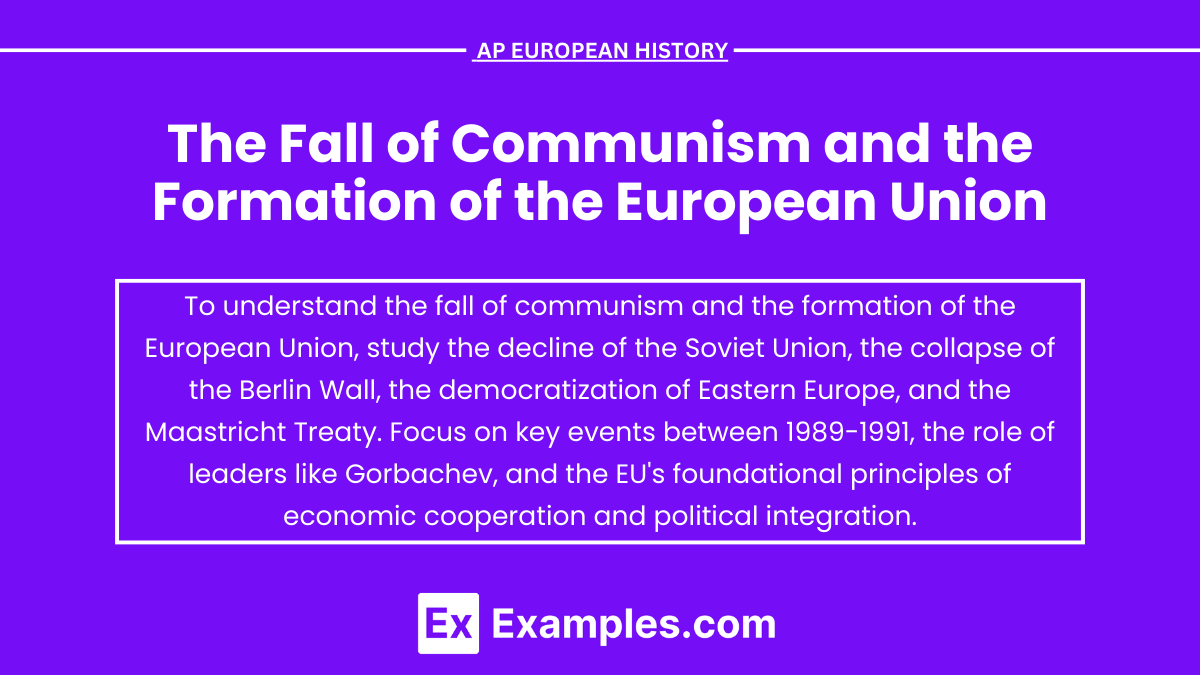The fall of communism and the formation of the European Union are pivotal events in modern European history, significantly impacting the continent’s political and economic landscape. As a key topic in AP European History, understanding these events helps to grasp the transition from authoritarian regimes to democratic governments in Eastern Europe. The establishment of the EU promoted economic integration and cooperation among member states, fostering stability and prosperity. These developments continue to influence Europe’s present and future dynamics.
Learning Objectives
By studying “The Fall of Communism and the Formation of the European Union,” you should be able to understand the key factors that led to the decline of communist regimes in Eastern Europe, including economic inefficiencies, political repression, and reformist movements. You should also grasp the major events and figures that contributed to the collapse of communism and the subsequent dissolution of the Soviet Union. Additionally, you should learn about the steps toward European integration, from early economic cooperation to the establishment and expansion of the European Union.
The Fall of Communism
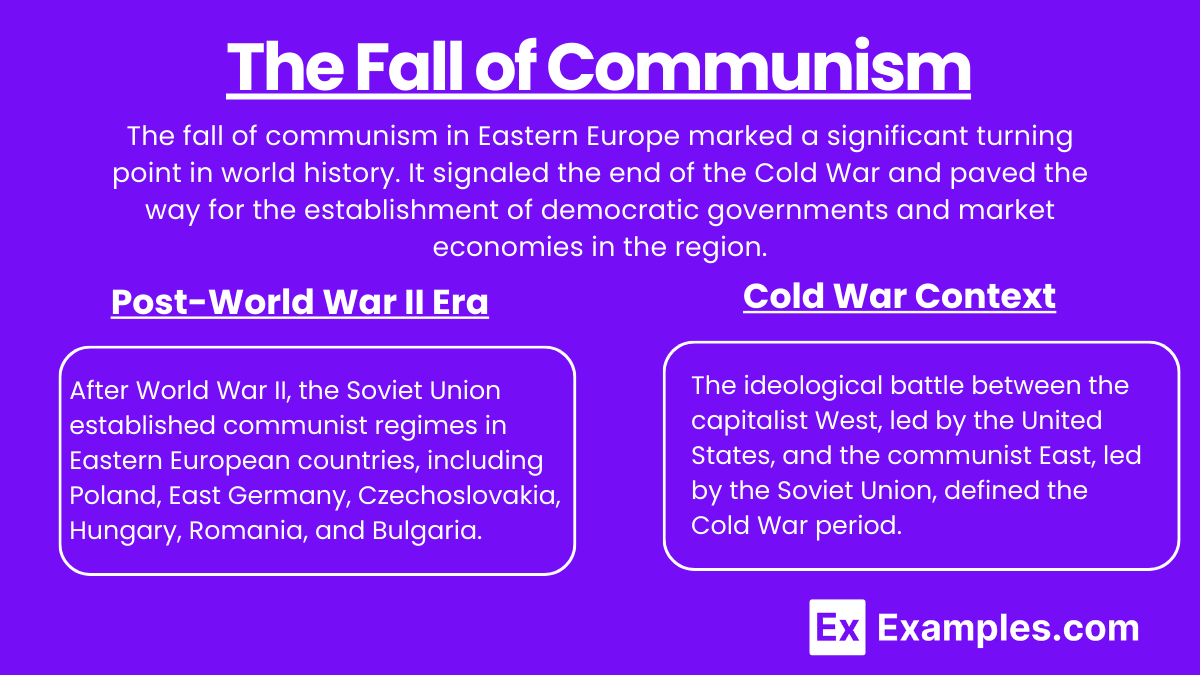
The fall of communism in Eastern Europe marked a significant turning point in world history. It signaled the end of the Cold War and paved the way for the establishment of democratic governments and market economies in the region.
Background of Communism in Eastern Europe
- Post-World War II Era: After World War II, the Soviet Union established communist regimes in Eastern European countries, including Poland, East Germany, Czechoslovakia, Hungary, Romania, and Bulgaria.
- Cold War Context: The ideological battle between the capitalist West, led by the United States, and the communist East, led by the Soviet Union, defined the Cold War period.
Key Factors Leading to the Fall of Communism
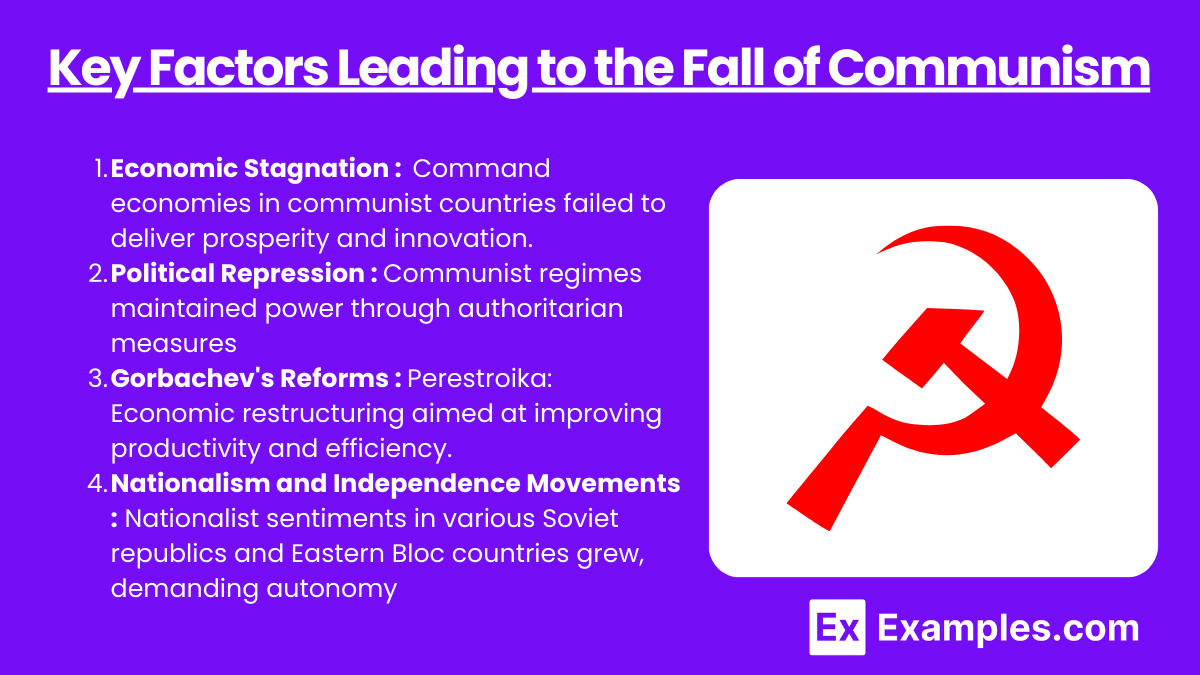
- Economic Stagnation:
- Command economies in communist countries failed to deliver prosperity and innovation.
- Shortages, inefficiency, and lack of consumer goods led to widespread dissatisfaction.
- Political Repression:
- Communist regimes maintained power through authoritarian measures, suppressing dissent and limiting freedoms.
- Dissidents and opposition movements gained support over time, challenging the status quo.
- Gorbachev’s Reforms:
- Perestroika: Economic restructuring aimed at improving productivity and efficiency.
- Glasnost: Increased openness and transparency in government, allowing more freedom of expression and criticism of the government.
- Nationalism and Independence Movements:
- Nationalist sentiments in various Soviet republics and Eastern Bloc countries grew, demanding autonomy and independence.
- Examples include Solidarity in Poland and independence movements in the Baltic states.
Major Events Leading to the Fall
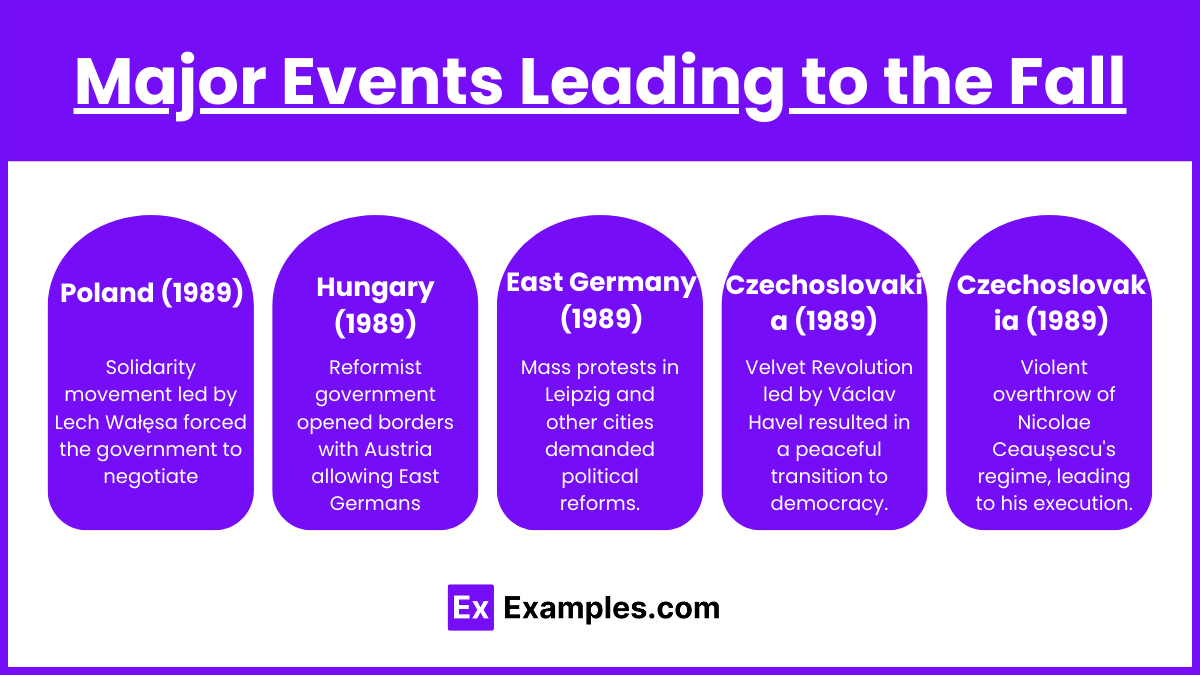
- Poland (1989):
- Solidarity movement led by Lech Wałęsa forced the government to negotiate, leading to semi-free elections.
- Solidarity’s victory marked the beginning of the end for communist rule in Eastern Europe.
- Hungary (1989):
- Reformist government opened borders with Austria, allowing East Germans to flee to the West.
- Symbolic dismantling of the Iron Curtain.
- East Germany (1989):
- Mass protests in Leipzig and other cities demanded political reforms.
- Fall of the Berlin Wall on November 9, 1989, became a symbol of the end of communism in Eastern Europe.
- Czechoslovakia (1989):
- Velvet Revolution led by Václav Havel resulted in a peaceful transition to democracy.
- Romania (1989):
- Violent overthrow of Nicolae Ceaușescu’s regime, leading to his execution.
The Collapse of the Soviet Union (1991)
- August Coup (1991): Failed coup by hardline communists accelerated the collapse.
- Independence Declarations: Baltic states and other republics declared independence.
- Dissolution: The Soviet Union officially dissolved on December 26, 1991, marking the end of communist rule in Russia and Eastern Europe.
Formation of the European Union
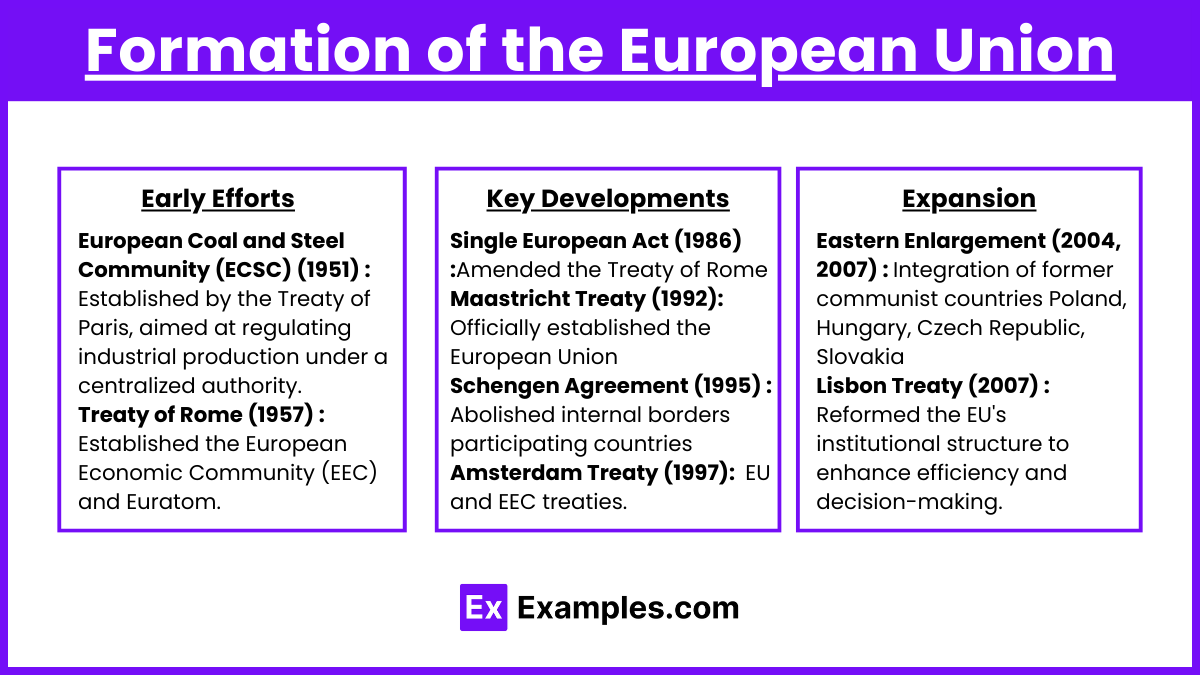
Early Efforts at European Integration
- European Coal and Steel Community (ECSC) (1951):
- Established by the Treaty of Paris, aimed at regulating industrial production under a centralized authority.
- Founding members: Belgium, France, Italy, Luxembourg, the Netherlands, and West Germany.
- Treaty of Rome (1957):
- Established the European Economic Community (EEC) and Euratom.
- Aimed at creating a common market and fostering economic cooperation.
Key Developments in European Integration
- Single European Act (1986):
- Amended the Treaty of Rome, setting the stage for the single market by 1992.
- Aimed at removing barriers to free movement of goods, services, people, and capital.
- Maastricht Treaty (1992):
- Officially established the European Union.
- Introduced the three-pillar structure: European Communities, Common Foreign and Security Policy (CFSP), and Justice and Home Affairs (JHA).
- Laid the groundwork for the Economic and Monetary Union (EMU) and the euro currency.
- Schengen Agreement (1995):
- Abolished internal borders between participating countries, allowing passport-free movement.
- Amsterdam Treaty (1997):
- Amended and renumbered the EU and EEC treaties.
- Enhanced powers of the European Parliament and streamlined decision-making processes.
Expansion of the European Union
- Eastern Enlargement (2004, 2007):
- Integration of former communist countries: Poland, Hungary, Czech Republic, Slovakia, Slovenia, Estonia, Latvia, Lithuania (2004); Romania and Bulgaria (2007).
- Aimed at promoting stability, democracy, and economic development in Eastern Europe.
- Lisbon Treaty (2007):
- Reformed the EU’s institutional structure to enhance efficiency and decision-making.
- Strengthened the role of the European Parliament and introduced the position of the President of the European Council.
Impact of the Fall of Communism and Formation of the EU
Political Impact
- Democratization: Former communist countries transitioned to democratic governance.
- Stability and Peace: European integration promoted political stability and reduced the likelihood of conflicts.
Economic Impact
- Economic Growth: Integration into the EU facilitated economic development and modernization of Eastern European economies.
- Single Market: Enhanced trade, investment, and economic cooperation across member states.
Social and Cultural Impact
- Freedom of Movement: Schengen Agreement allowed for greater cultural exchange and mobility.
- Human Rights: EU membership required adherence to human rights and democratic principles.
Challenges and Criticisms
- Economic Disparities: Differences in economic development levels between Western and Eastern European countries.
- Sovereignty Concerns: Debates over national sovereignty versus supranational EU authority.
- Migration and Integration: Issues related to immigration and integration of diverse populations.
The fall of communism and the formation of the European Union were transformative events in European history. The collapse of communist regimes paved the way for democratization and economic reforms, while the EU fostered unprecedented levels of cooperation and integration among European nations. These developments continue to shape the political, economic, and social landscape of Europe today.
Examples
Example 1: Poland’s Solidarity Movement (1980-1989)
The rise of the Solidarity movement, led by Lech Wałęsa, played a crucial role in the fall of communism in Poland. The movement’s success inspired other Eastern European countries to seek similar changes.
Example 2: The Fall of the Berlin Wall (1989)
The destruction of the Berlin Wall symbolized the end of the Cold War and the collapse of communist regimes in Eastern Europe. This pivotal event paved the way for German reunification and a shift towards democracy.
Example 3: The Velvet Revolution in Czechoslovakia (1989)
A peaceful transition from communism to a parliamentary republic occurred in Czechoslovakia. The Velvet Revolution was characterized by non-violent protests, leading to the end of communist rule and the eventual split into the Czech Republic and Slovakia.
Example 4: The Collapse of the Soviet Union (1991)
The dissolution of the Soviet Union marked the definitive end of communist dominance in Eastern Europe. This collapse led to the independence of several former Soviet states and the spread of democratic governance.
Example 5: The Maastricht Treaty (1992)
The Maastricht Treaty was a significant step in the formation of the European Union. It established the framework for a closer political and economic union among European nations, which included former communist countries transitioning to democracy and market economies.
Multiple Choice Questions
Question 1
What was one of the primary factors that led to the fall of communism in Eastern Europe in the late 20th century?
a) Economic prosperity
b) Widespread social equality
c) Political reforms and public dissatisfaction
d) Increased military strength
Answer: c) Political reforms and public dissatisfaction
Explanation: The fall of communism in Eastern Europe was primarily driven by political reforms and widespread public dissatisfaction with the existing regimes. In the 1980s, Mikhail Gorbachev’s policies of glasnost (openness) and perestroika (restructuring) in the Soviet Union sparked a wave of political reforms across Eastern Europe. These changes exposed the inefficiencies and corruption within communist governments, leading to mass protests and demands for democratic reforms. As a result, many communist regimes collapsed, paving the way for democratic governments and the eventual dissolution of the Soviet Union in 1991.
Question 2
Which treaty marked the formal creation of the European Union?
a) Treaty of Versailles
b) Maastricht Treaty
c) Treaty of Rome
d) Treaty of Paris
Answer: b) Maastricht Treaty
Explanation: The Maastricht Treaty, signed in 1992, marked the formal creation of the European Union (EU). This treaty, officially known as the Treaty on European Union, established the three-pillar structure of the EU, which included the European Communities, Common Foreign and Security Policy (CFSP), and Justice and Home Affairs (JHA). The Maastricht Treaty also introduced the concept of European citizenship, enhanced cooperation in economic and monetary policies, and set the stage for the creation of the euro. It was a significant step in the process of European integration, transforming the European Economic Community (EEC) into a more politically unified entity.
Question 3
What was a significant outcome of the fall of communism in Eastern Europe for the countries in that region?
a) Isolation from the global community
b) Rapid industrial decline
c) Integration into European and international organizations
d) Increased political instability
Answer: c) Integration into European and international organizations
Explanation: A significant outcome of the fall of communism in Eastern Europe was the integration of these countries into European and international organizations. Following the collapse of their communist regimes, many Eastern European nations sought closer ties with Western Europe and the broader international community. They embarked on political and economic reforms to transition to market economies and democratic governance. This led to their eventual membership in organizations such as the European Union and NATO, which provided political stability, economic support, and security assurances. The integration into these organizations was crucial for the development and modernization of post-communist Eastern Europe.

